Noe hangs out with Yan after breakfast.
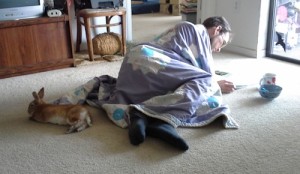
The blanket is because it’s a wee bit cold this morning.
My recent blog silence has been partially because I’ve been getting ready to present research at the 2103 American Geophysical Union (AGU) Fall Meeting. I’ve been working on a comparative analysis of online interactive sea level rise viewers, which are used to help people visualize the potential effects of sea level rise on coastlines. I’ll be presenting some of the results at the conference as a poster presentation on Monday afternoon, titled “Building Stories about Sea Level Rise through Interactive Visualizations” (Paper Number PA13A-1762, for anyone who sees this and is interested in talking to me :))
Here’s the introduction:
Sea level rise (SLR) is an aspect of global climate change that can be communicated effectively using visuals. We focus on online interactive SLR viewers, which: visualize SLR or coastal areas that could potentially be affected by SLR; allow users to interact with the visualization by scrolling, zooming, and other features related to view selection; use a map as a base layer; and are located online. SLR viewers can visualize a range of SLR scenarios to communicate about possible coastal impacts. They let us represent the effects and risks of SLR for coastal planning and community outreach. As users interact with SLR viewers, they build personalized narratives about SLR’s effects and risks. By helping audiences visualize the potential impacts of SLR in locations that are personally important to them, we can motivate them to try to understand SLR and support efforts to mitigate or respond to it.
And here’s a pdf version of it: Stephens AGU poster. Please note the screenshots in the poster are copyrighted by their respective creators. I’ve also collaborated on two other presentations related to science communication in general:
D. E. DeLorme, S. C. Hagen, & S. H. Stephens, 2013. “Strategies for Sharing Scientific Research on Sea Level Rise: Suggestions from Stakeholder Focus Groups.”
S. C. Hagen, S. H. Stephens, D. E. DeLorme, D. Ruple, & L. Graham, 2013. “Increasing Public Access to Scientific Research through Stakeholder Involvement: Ecological Effects of Sea Level Rise in the Northern Gulf of Mexico.”
I’ve never been to an AGU meeting before, and from what I hear, it can be an overwhelming experience (>20,000 people attending!). But I’m armed with a list of interesting presentations that I want to see and am meeting up with some folks there, so it should be interesting. Of course, I’m also hoping to get some birding in while I’m there- at least see the famous San Francisco parrots!
While Noe is having a mellow Thanksgiving weekend, we’ve seen a few swamp rabbits while going for a walk.
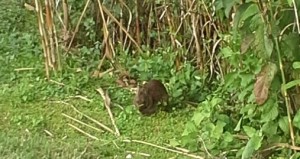
Okay, not such a great photo. But the rabbits were seemingly enjoying themselves munching on clover at Lakes Park in Fort Myers.
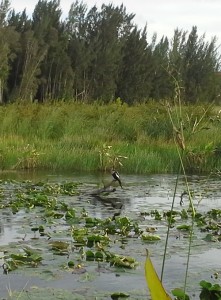
There were a few birds around, but it was a bit windy and late in the day so not too much activity on that front.
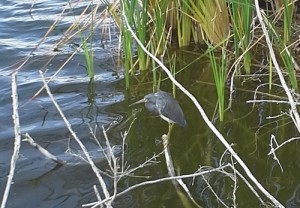
Not too many flowers blooming, either. This is a Hoarypea, Tephrosia spp.
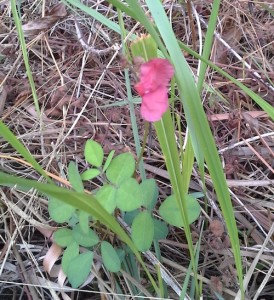
Continuing our trend of snake sightings, we saw a Black Racer sunning itself. Unlike the rattlers we saw last month, this one was pretty long- at least a meter.
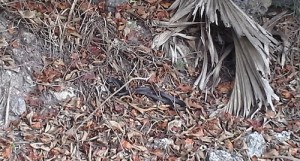
Last weekend, we went biking at Orlando Wetlands Park. It was the last weekend to visit before the park closes for the winter, and quite a nice day. We actually saw a fair variety of birds- including a lifer painted bunting, a pair of somewhat early canvasbacks, five species of warbler, a kestrel, and a Wilson’s snipe. You can tell it’s winter in Florida when the shrubs are hopping with yellow-rumped and palm warblers, and they were in fine form at OWP.
One thing about bike-birding that I’d never really thought about before is that it’s much easier to spot snakes before you get too close to them. This is a net positive, as far as I’m concerned 🙂 We saw two species of rattlesnake today, both crossing the berm trail or maybe sunning on it, and both only moderately put out at us riding by.
I’ve seen eastern diamondback rattlesnakes before, and this one was only about two feet or so long. Still, I was more than happy to let it do its thing in peace. We gave it a pretty wide berth, but not before Yan stopped and took a photo:
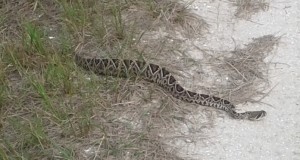
The pygmy rattlesnake I hadn’t seen before, bringing me four for four on seeing Central Florida’s venomous species (the other two being the cottonmouth and coral snake). This snake was a bit over a foot long, and much more petite than the diamondback. Notice how tiny the rattle is? It’s on the right end:
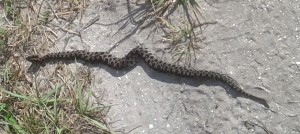
While Yan was taking this photo, he said it started to rattle at him in sort of a cute, hard-to-hear way. At that point, he left it alone and we biked on.
So, not a terribly exciting pair of snake sightings, but I’m okay with that. We did encounter some fairly territorial dragonflies who seemed irritated at our presence (the males seem to do this guarding thing at certain times of the year). But since we’re way past the Carboniferous Period dragonflies with 2-foot wingspans, they weren’t particularly intimidating. The 6-foot gator we saw was a bit more threatening, but he was pointed away from us at the time. Strangely, we didn’t get off our bikes to take photos of him…
Noe is very tidy, and always cleans up after eating.
Done with juice? Must be clean-up time.
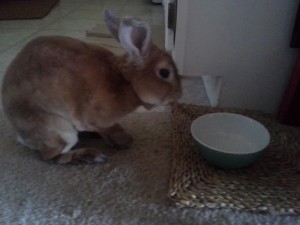
It’s very important to wash your face after breakfast.
Of course, this fastidiousness doesn’t extend past her own self. She has no problem with dripping water on the floor or scattering hay all over the place.
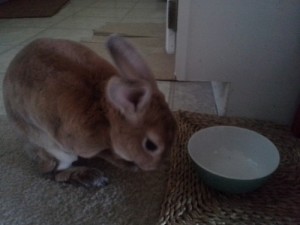 Apparently, it’s the humans’ job to take care of that sort of thing.
Apparently, it’s the humans’ job to take care of that sort of thing.
The Hawaiian Islands have very few permanent natural lakes. In fact, there are only four lakes on the main Hawaiian Islands (there is one on Laysan Island, as well). All four sit in the bottom of volcanic cinder cones or craters, making them pretty small in area, but potentially very deep.
Lake Waiau has been in the news for the last few weeks for a very disturbing reason- it has been shrinking. A lot. As of late September, it was only at about 2% of its normal surface area!
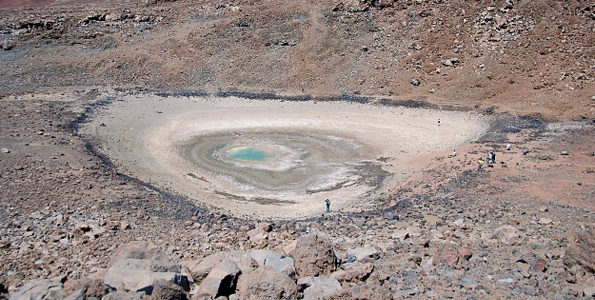
Lake Waiau’s dramatic shrinking has been going on for at least a year. The reasons are not well understood, but are most likely linked to an ongoing drought in Hawaii, combined with rising temperatures. The lake is perched on what is normally really permeable volcanic cinders (think pumice stone). A layer of clay, permafrost, or some combination of the two (scientists aren’t sure which) rests under the lake bed, normally making the cinders stick together and holding the water in place.
In case you’re wondering, yes- permafrost. During the last Ice Age, there were glaciers on Mauna Loa and Mauna Kea, and there may still be frozen ground a bit under the surface of the top of Mauna Kea (Mauna Loa is too volcanically active). But if the lake is resting on permafrost, its days are numbered. High-altitude temperatures are increasing three times higher on Mauna Kea than the global average. Even if there’s not a melting layer of permafrost underneath, rising temperatures mean more evaporation, and when combined with little winter snowfall, clearly the lake is already in trouble.
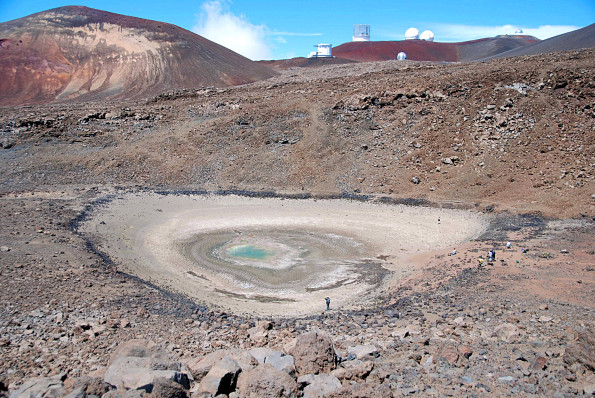
As the only alpine lake in Hawaii, Lake Waiau was and is sacred to Native Hawaiians. From a scientific standpoint, its geology and ecology are unique. While its current problems likely stem from drought, its future is tied to our warming climate. Like many other unique and culturally significant locations worldwide, Lake Waiau’s fate seems to be one of drastic change.
Last night, we had some “fun” with Noe.
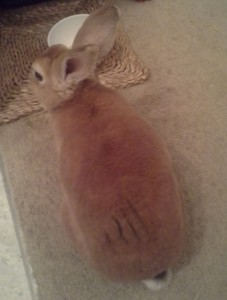
Apparently, she’d brushed up against one of the bike chains hard enough to get a bunch of grease and dirt on her fur. While it made a striking stripe pattern, we didn’t want her to lick it off. So we tried using a damp paper towel with some soap on it.
When that didn’t work, we tried to snip it out with scissors. When that didn’t work (rabbit fur being very fine and difficult to keep between the blades), we resorted to Yan’s beard trimmer. That at least worked enough to get the worst of the grease off.
We didn’t have to trim off too much fur, because at least the grease was in the top layer. But now she has this hacked-off looking spot of pale fur on her back where her brown overcoat was trimmed down. It’ll be interesting to explain this to the vet when she goes in for her yearly checkup on Monday…
I just ran across this cute story about an elderly Rex rabbit and a black vulture (don’t worry, it ends well).
Makes me wonder how Noe would react to another non-human animal in the house…though given how freaked out she was today by my backpack being placed in the wrong location, it would probably take her a while to get used to the idea of another animal who actually moves.
We paid a visit to California this summer, including some (literal) highs and lows. For the highs, we traveled to Sequoia National Park; for the lows, we visited the Kern River valley (more on that anon).
The literal high point of our trip to Sequoia was hiking up Moro Rock, elevation 2050 meters.
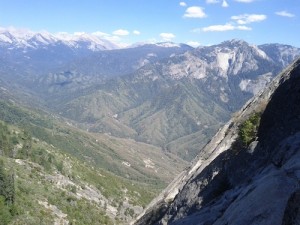
Not being a fan of heights, the walk up the rock face was a bit disturbing in spots. There are a few narrow spots in the trail with a rock face looming overhead and a pretty short railing above a steep drop-off. The view from the top was breathtaking, though.
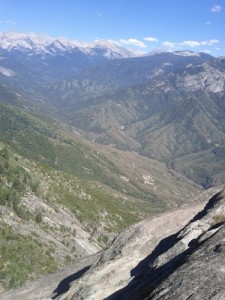
It was pretty cool to see other granite domes in the distance, like Moro Rock. There was also some snow to see, tucked into high valleys of the taller peaks. Really odd to see, given the mid-80’s temperatures we had in the park. But snow is always exciting to us Floridians!
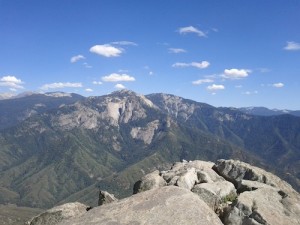
Of course, the highlight of this part of the trip was seeing the giant sequoias. And they were quite spectacular…
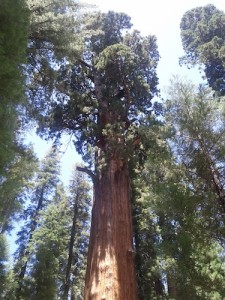
We’re currently halfway through the 2013 Sea Level Rise Summit in Fort Lauderdale. I have a poster up at the meeting about the coastal dynamics of sea level rise project (or Ecological Effects of Sea Level Rise in the Northern Gulf of Mexico/EESLR-NGOM).
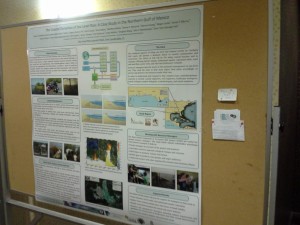
After having listened to and interacted with a wide variety of people from the sciences, communication, law, politics, and public health, the highlight of the day has to be stepping out of a car downtown on the way to the evening’s reception and nearly missing going ankle-deep into a puddle of seawater rising up through a storm drain. South Florida has a major problem with sea level rise and salt water intruding into the cities-so much so that on a completely rainless day with no wind, a high tide can push water up through the grates. So this was a perfect illustration of the challenges that this region faces in the future.